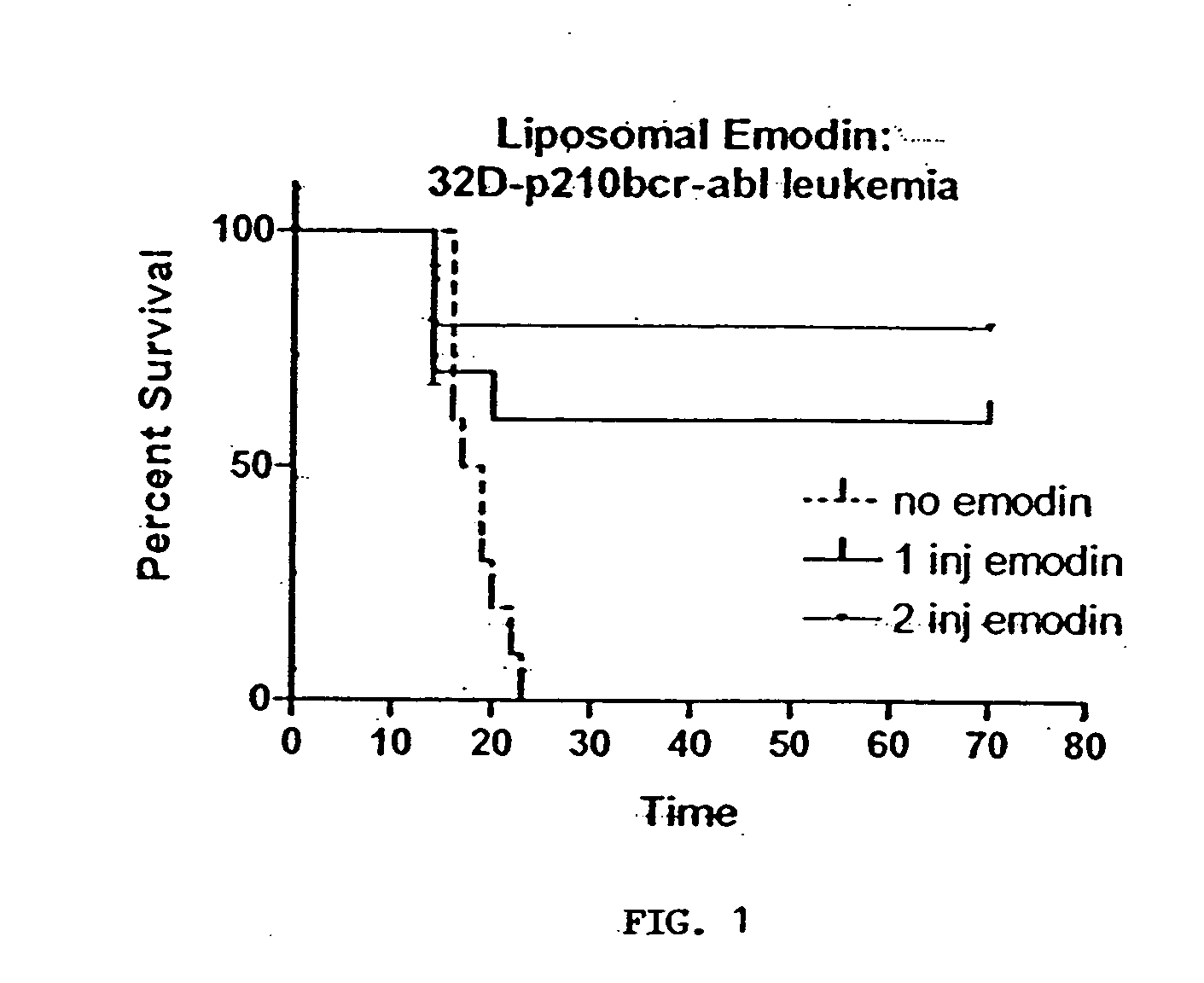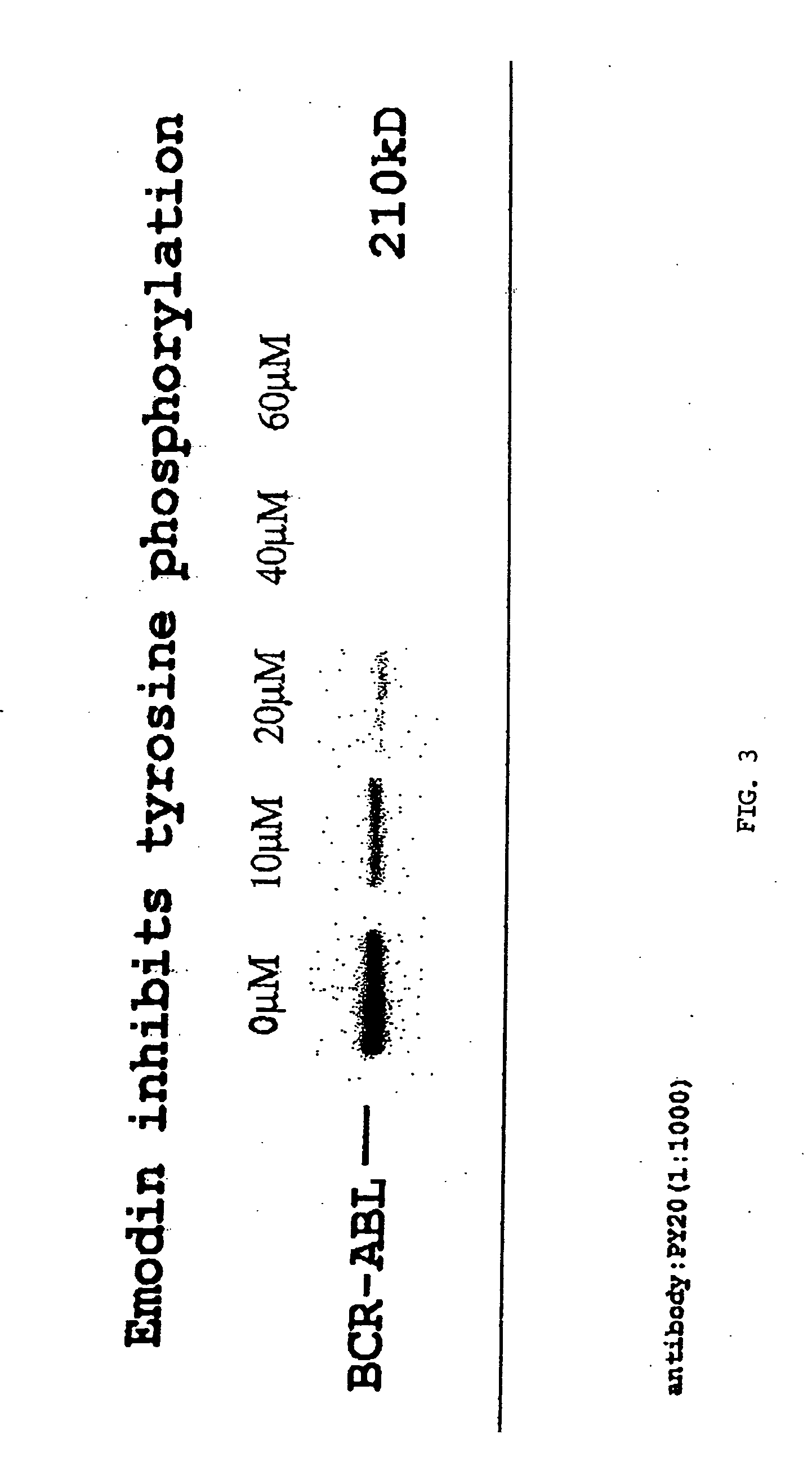Compositions and methods related to lipid:emodin formulations
a technology of lipids and formulations, applied in the field of cancer therapies, to achieve the effect of reducing the problems associated, high concentration, and long duration of drug action
- Summary
- Abstract
- Description
- Claims
- Application Information
AI Technical Summary
Benefits of technology
Problems solved by technology
Method used
Image
Examples
example 1
[0086] Material and Methods
[0087] This information is for a non-limiting exemplary lipid:emodin formulation or preparation. Emodin was prepared in t-butanol (Sigma St. Louis, Mo.) at a concentration of 1 mg / ml. T-butanol was warmed to 37° C., emodin was added and vortexed. The emodin / t-butanol mixture was then added to a lipid mixture. An exemplary lipid mixture is DMPC in t-butanol at concentration of 5 mg / ml. Other preparations were made using a combination of lipids (DMPC and DMPG) in ratios of 7:3, 5:2, and 1:1, but these preparations did not perform as well as DMPC alone. Tween 20 was added to the lipid mixture as a 10% solution (1 ml tween 20+9 ml t-butanol). In this particular example 300 μl of a 10% tween solution was added to the lipid mixture. The preparation therefore would have a 0.08% concentration of Tween 20 (0.3 ml×10% divided by 35.3 ml (total volume)=0.08%. Drying methods used were a lyophilizer and a speed vac. Both methods were utilized without heat and gave a s...
example 2
[0089] Emodin Treatment in C3H-HEJ Mouse Model
[0090] The leukemia strain 32D-bcr-abl was used, given at 1×106 cells per CEH / HEJ mouse. The cell line is a 32D-P210 strain. The lipid:emodin formulation was run twice using an injection of the animal model of 0.2 mg emodin per animal. This formulation led to a product that was inconsistent with samples previously received by the Inventors from another laboratory. This prior formulation had been used for all of the cell culture work until this particular study. The product produced for this set of studies was likened to orange juice with pulp, as it had particulate matter that had not dissolved upon addition of saline. Injection into the mice was relatively easy, but reaction of the particulate in vivo was not definitive.
[0091] The results of the above described study was of 53 mice receiving on injection of 0.2 mg emodin, 8 died within the first two weeks of injection. Of the 51 that received two injections of 0.2 mg emodin, 9 died in...
example 3
[0093] DMSO Solubilized Emodin Studies
[0094] In Vitro: A tetracycline regulatable 32D-P210 cell line was cultured in RPMI 1640 with 10% FCS and 10% Wehi supernatant and cultured at 37° C. Emodin was solubilized in DMSO at a concentration of 0.4 M for in vitro assays. A concentration of 3×104 cells / ml were used in a 24 well plate for a 3 day exposure to emodin. Emodin was assayed at 60 μM, 30 μM, and 10 μM concentrations. At 72 hours, a MTT assay was performed to provide a colorometric analysis of cell growth.
[0095] In vivo: The mouse strain C3H-HEJ (8-10 weeks old) were used for in vivo studies. Emodin was prepared in an alkaline preparation at 10 mg / ml, and was administered to the animals via tail vein injections. One cohort of animals received a single dose of emodin equal to 43 mg / kg per animal. Two other cohorts received either two doses of drug, administered on consecutive days, or there doses of drug, administered on consecutive days. The total concentration of drug administ...
PUM
| Property | Measurement | Unit |
|---|---|---|
| body weight | aaaaa | aaaaa |
| body weight | aaaaa | aaaaa |
| body weight | aaaaa | aaaaa |
Abstract
Description
Claims
Application Information
 Login to View More
Login to View More - R&D
- Intellectual Property
- Life Sciences
- Materials
- Tech Scout
- Unparalleled Data Quality
- Higher Quality Content
- 60% Fewer Hallucinations
Browse by: Latest US Patents, China's latest patents, Technical Efficacy Thesaurus, Application Domain, Technology Topic, Popular Technical Reports.
© 2025 PatSnap. All rights reserved.Legal|Privacy policy|Modern Slavery Act Transparency Statement|Sitemap|About US| Contact US: help@patsnap.com



